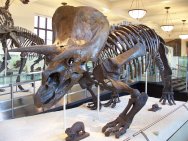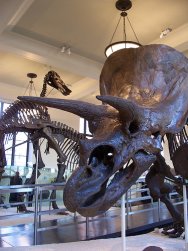 Triceratops
was a herbivorous genus of ceratopsid dinosaur that lived during
the late Maastrichtian stage of the Late Cretaceous Period, around
68 to 65 million years ago (mya) in what is now North America. This
makes it one of the last dinosaur genera to appear before the Cretaceous–Tertiary
extinction event. It is most famously recognized by a large bony
frill and three horns. In fact, its name means "three-horned
face,". Alhough it shared its terrestrial environment with
the Triceratops
was a herbivorous genus of ceratopsid dinosaur that lived during
the late Maastrichtian stage of the Late Cretaceous Period, around
68 to 65 million years ago (mya) in what is now North America. This
makes it one of the last dinosaur genera to appear before the Cretaceous–Tertiary
extinction event. It is most famously recognized by a large bony
frill and three horns. In fact, its name means "three-horned
face,". Alhough it shared its terrestrial environment with
the  Tyrannosaurus,
science has no evidence that it fought Tyrannosaurus in the manner
often depicted in movies and children's dinosaur books. Triceratops
is perhaps the best known of the ceratopsid dinosaurs. Its placement
within the group has long been in contention amongst paleontologists.
Two species, Triceratops horridus and Triceratops prorsus, are considered
valid, although many other species have been named. Tyrannosaurus,
science has no evidence that it fought Tyrannosaurus in the manner
often depicted in movies and children's dinosaur books. Triceratops
is perhaps the best known of the ceratopsid dinosaurs. Its placement
within the group has long been in contention amongst paleontologists.
Two species, Triceratops horridus and Triceratops prorsus, are considered
valid, although many other species have been named.
Triceratops
are estimated to have reached some 26 feet long, 10 feet tall, and
6.1 tonnes (13,400 lb) in weight. A complete skeleton of Triceratops
has not yet been found, but it has been well described and studied
from many partial specimens discovered beginning in the late 19th
century. The function of the frills and three distinctive facial
horns has been long debated. Although traditionally viewed as defensive
weapons against predators, the latest theories claim that it is
more probable that these features were used in courtship and dominance
displays, much like the antlers and horns of deer and goats.
|



